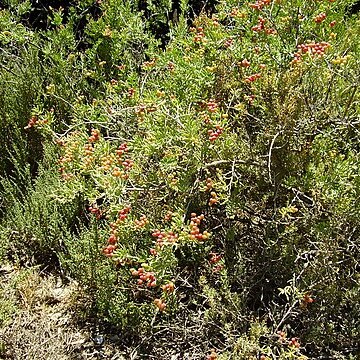Rounded, sprawling, untidy and impenetrable woody shrubs, up to 2 m high and 5 m wide, spiny on some branch ends. Young branches closely appressed-pubescent with white hairs, glabrous with age; bark white initially, eventually pale grey. Leaves in whorls of 3–6, thick, narrowly obovate, 1–4 cm long, attenuate, entire, acute, initially densely appressed-pubescent, eventually glabrous, green or grey-green; stipules triangular. Flowers unisexual or bisexual on any one bush, sometimes mixed. Sepals united at base; lobes 0.5–1.5 mm long, acute or acuminate. Petals 2.5–3.5 mm long. Fertile stamens 11–15 in male or bisexual flowers; filaments 3–4 mm long, exceeding petals and stigma; staminodes 11–15 in female flowers, of similar height to stigma. Ovary densely white-appressed-pubescent; hairs continuous about stigma lobes. Fruit ovoid, 1–2 cm long, initially green, green-yellow, red or purple when ripe.
More
A small shrub. It grows 1-2 m high and spreads 3-5 m wide. Young growth is hairy. The branches spread widely and often arch over. The small branches are often spiny and tangled. The leaves are 1-4 cm long by 0.1-0.3 cm wide. The leaves are simple and deeply lobed. They are arranged in spirals. The flowers are 0.5 cm across. They are white and occur in small clusters along the branches. The fruit are 1-2 cm long by 0.5-1 cm wide. They are oblong and fleshy. They can be golden, purple or red.

